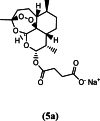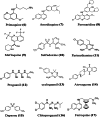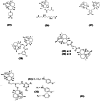Enhancing the antimalarial activity of artesunate
- PMID: 32638101
- PMCID: PMC7340003
- DOI: 10.1007/s00436-020-06786-1
Enhancing the antimalarial activity of artesunate
Abstract
The global challenge to the treatment of malaria is mainly the occurrence of resistance of malaria parasites to conventionally used antimalarials. Artesunate, a semisynthetic artemisinin compound, and other artemisinin derivatives are currently used in combination with selected active antimalarial drugs in order to prevent or delay the emergence of resistance to artemisinin derivatives. Several methods, such as preparation of hybrid compounds, combination therapy, chemical modification and the use of synthetic materials to enhance solubility and delivery of artesunate, have been employed over the years to improve the antimalarial activity of artesunate. Each of these methods has advantages it bestows on the efficacy of artesunate. This review discussed the various methods employed in enhancing the antimalarial activity of artesunate and delaying the emergence of resistance of parasite to it.
Keywords: Artesunate; Combination therapy; Enhanced activity; Hybrids; Malaria.
Conflict of interest statement
The authors declare that they have no conflicts of interest.
Figures







Similar articles
-
Artemisinin derivatives and malaria: useful, in combination with other antimalarials.Prescrire Int. 2008 Aug;17(96):162-8. Prescrire Int. 2008. PMID: 19492494
-
[Combined antimalarial therapy using artemisinin].Parassitologia. 2004 Jun;46(1-2):85-7. Parassitologia. 2004. PMID: 15305693 Review. Italian.
-
High-level artemisinin-resistance with quinine co-resistance emerges in P. falciparum malaria under in vivo artesunate pressure.BMC Med. 2018 Oct 1;16(1):181. doi: 10.1186/s12916-018-1156-x. BMC Med. 2018. PMID: 30269689 Free PMC article.
-
Parasite Viability as a Superior Measure of Antimalarial Drug Activity in Humans.J Infect Dis. 2021 Jun 15;223(12):2154-2163. doi: 10.1093/infdis/jiaa678. J Infect Dis. 2021. PMID: 33119072
-
How genomics is contributing to the fight against artemisinin-resistant malaria parasites.Acta Trop. 2015 Aug;148:1-7. doi: 10.1016/j.actatropica.2015.04.007. Epub 2015 Apr 21. Acta Trop. 2015. PMID: 25910626 Review.
Cited by
-
Unrevealing the therapeutic potential of artesunate against emerging zoonotic Babesia microti infection in the murine model.Front Vet Sci. 2024 May 9;11:1383291. doi: 10.3389/fvets.2024.1383291. eCollection 2024. Front Vet Sci. 2024. PMID: 38784653 Free PMC article.
-
Anti-tumor mechanism of artesunate.Front Pharmacol. 2024 Oct 25;15:1483049. doi: 10.3389/fphar.2024.1483049. eCollection 2024. Front Pharmacol. 2024. PMID: 39525639 Free PMC article. Review.
-
Advances in the study of artemisinin and its derivatives for the treatment of rheumatic skeletal disorders, autoimmune inflammatory diseases, and autoimmune disorders: a comprehensive review.Front Immunol. 2024 Oct 25;15:1432625. doi: 10.3389/fimmu.2024.1432625. eCollection 2024. Front Immunol. 2024. PMID: 39524446 Free PMC article. Review.
-
Synthesis and Characterization of Dimeric Artesunate Glycerol Monocaprylate Conjugate and Formulation of Nanoemulsion Preconcentrate.Molecules. 2023 Jul 4;28(13):5208. doi: 10.3390/molecules28135208. Molecules. 2023. PMID: 37446870 Free PMC article.
-
The Medicines for Malaria Venture Malaria Box contains inhibitors of protein secretion in Plasmodium falciparum blood stage parasites.Traffic. 2022 Sep;23(9):442-461. doi: 10.1111/tra.12862. Epub 2022 Aug 15. Traffic. 2022. PMID: 36040075 Free PMC article.
References
-
- Adebayo JO, Santana AE, Krettli AU. Evaluation of the antiplasmodial and cytotoxicity potentials of husk fibre extracts from Cocos nucifera, a medicinal plant used in Nigeria to treat human malaria. Hum Exp Toxicol. 2012;31(3):244–249. - PubMed
-
- Adjuik M, Agnamey P, Babiker A, Borrmann S, Brasseur P, Cisse M, Cobelens F, Diallo S, Faucher JF, Garner P, Gikunda S, Kremsner PG, Krishna S, Lell B, Loolpapit M, Matsiegui PB, Missinou MA, Mwanza J, Ntoumi F, Olliaro P, Osimbo P, Rezbach P, Some E, Taylor WR. Amodiaquine-artesunate versus amodiaquine for uncomplicated Plasmodium falciparum malaria in African children: a randomised, multicentre trial. Lancet 20. 2002;359(9315):1365–1372. - PubMed
-
- Agnandji ST, Lell B, Soulanoudjingar SS, et al. Clinical trials partnership efficacy and safety of RTS,S/AS01 malaria vaccine with or without a booster dose in infants and children in Africa: final results of a phase 3, individually randomised, controlled trial. Lancet. 2015;386(9988):31–45. - PMC - PubMed
-
- Al-Qaraghuli M, Alzahrani A, Niwasabutra K, Obeid M, Ferro V. Where traditional drug discovery meets modern technology in the quest for new drugs. Ann Pharmacol Pharmaceutics. 2017;11:1061.
Publication types
MeSH terms
Substances
LinkOut - more resources
Full Text Sources

